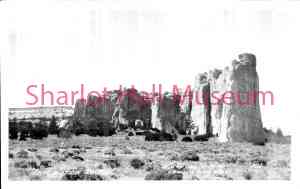Inscription Rock Petroglyphs - New Mexico
details
J.R. Willis, Gallup, New Mexico Unknown inpe1202p.jpg IN-PE-1202 B&W 1506-1202-0000 inpe1202p Postcard 3x5 Historic Photographs 1940s Reproduction requires permission. Digital images property of SHM Library & ArchivesDescription
A distance photo of Inscription Rock at El Morro National Monument, near Gallup, New Mexico.
In the high desert, water is difficult to find, and a permanent spring that forms a pool is very rare indeed. The spring at the El Morro bluff, hidden at the base of a cliff, has flowed for a thousand years or more. The pool has served as an oasis for groups including Native Americans, Spanish conquistadores, and 19th-century emigrants, and they have all left their mark.
Hundreds of years ago, local Ancestral Puebloan people built dwellings on top of the mesa and farmed the surrounding land. Although they carved inscriptions and petroglyphs in the rock wall by the spring, their story has been mostly lost to time. The ancient Zuni Indians developed pueblos near water sources and large sandstone structures on which they carved the petroglyphs that still remain today.
Then in the late 1500s, men in steel suits with steel swords and lead shot came to conquer the land and the peoples that still lived there. One of the conquistadores, Juan de Oñate, was “given” the land to settle, which he did with a vengeance. After massacring and enslaving the people of the Acoma Pueblo, he left his mark on the wall of El Morro in 1605. It is one of the earliest markings by European colonists in America, 15 years before the Pilgrims landed at Plymouth Rock.
Oñate was followed by others. One soldier couldn’t resist adding to his commander’s inscription, “The 14th day of July 1736 passed by here the General Juan Paez Hurtado, Inspector,” with the addendum, “And in his company, the Corporal Joseph Trujillo!” Another name is that of P. Gilmer Breckinridge, a wrangler for the U.S. Camel Corps under Lt. Edward Beale.
In the years that followed, countless more soldiers and American settlers, both well known and lost to history, came through the desert and left their mark at this watering hole. There are now around 2,000 signatures at the base of the cliff, and the El Morro National Monument was established to protect this unique historical record.
Purchase
To purchase this image please click on the NOTIFY US button and we will contact you with details
The process for online purchase of usage rights to this digital image is under development. To order this image, CLICK HERE to send an email request for details. Refer to the ‘Usage Terms & Conditions’ page for specific information. A signed “Permission for Use” contract must be completed and returned. Written permission from Sharlot Hall Museum is required to publish, display, or reproduce in any form whatsoever, including all types of electronic media including, but not limited to online sources, websites, Facebook Twitter, or eBooks. Digital files of images, text, sound or audio/visual recordings, or moving images remain the property of Sharlot Hall Museum, and may not be copied, modified, redistributed, resold nor deposited with another institution. Sharlot Hall Museum reserves the right to refuse reproduction of any of its materials, and to impose such conditions as it may deem appropriate. For certain scenarios, the price for personal usage of the digital content is minimal; CLICK HERE to download the specific form for personal usage. For additional information, contact the Museum Library & Archives at 928-445-3122 ext. 14 or email: orderdesk@sharlot.org.




